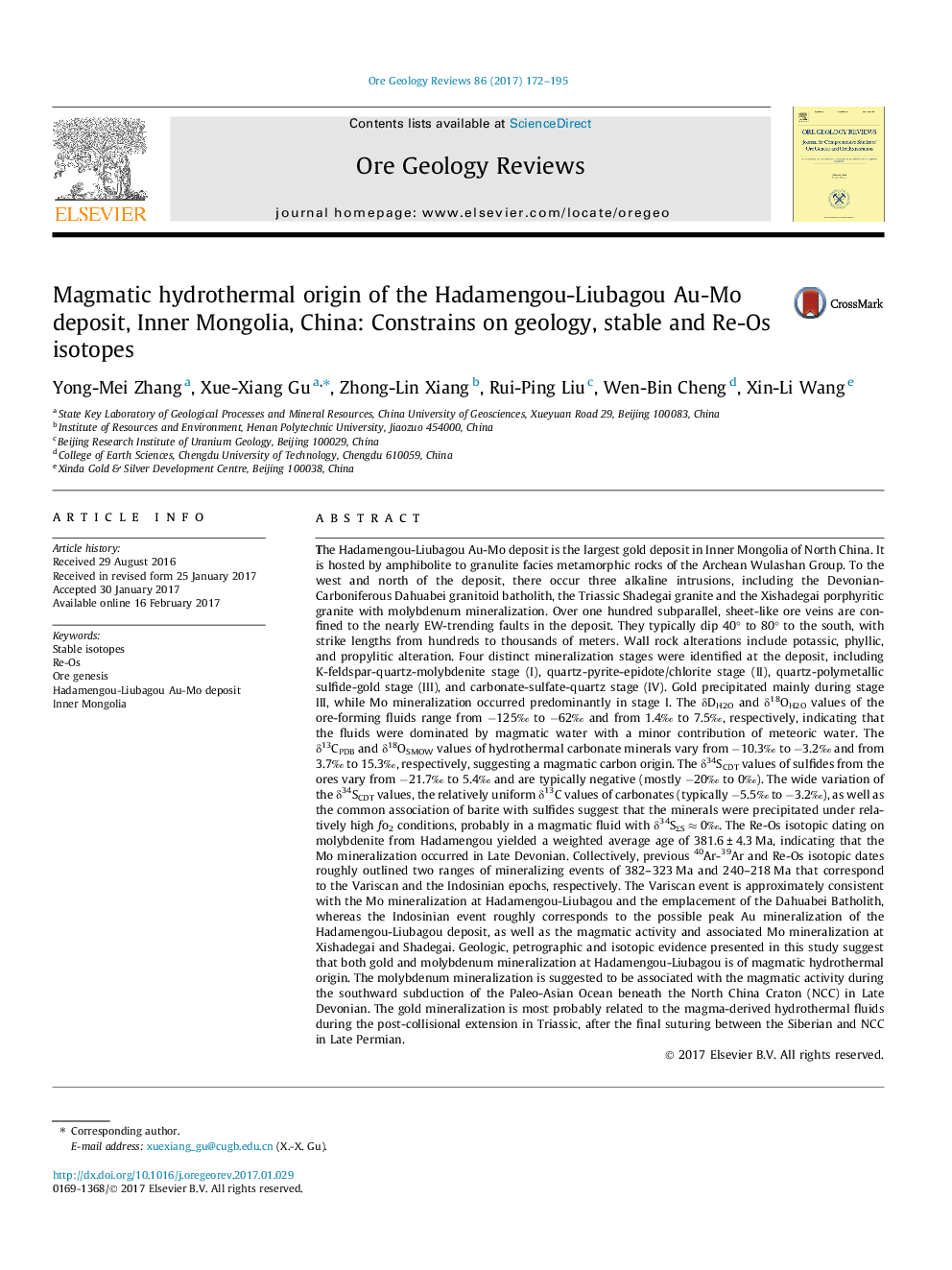| کد مقاله | کد نشریه | سال انتشار | مقاله انگلیسی | نسخه تمام متن |
|---|---|---|---|---|
| 5782399 | 1637221 | 2017 | 24 صفحه PDF | دانلود رایگان |

- The Hadamengou-Liubagou Au-Mo deposit is of magmatic hydrothermal origin.
- Gold and molybdenum mineralization occurred mainly in stage III and stage I.
- Ore-forming fluids were dominated by magmatic water with minor meteoric water.
- Sulfur and carbon isotopes suggest a magmatic origin.
- There exists Variscan and Indosinian mineralization associated with magmatic activities.
The Hadamengou-Liubagou Au-Mo deposit is the largest gold deposit in Inner Mongolia of North China. It is hosted by amphibolite to granulite facies metamorphic rocks of the Archean Wulashan Group. To the west and north of the deposit, there occur three alkaline intrusions, including the Devonian-Carboniferous Dahuabei granitoid batholith, the Triassic Shadegai granite and the Xishadegai porphyritic granite with molybdenum mineralization. Over one hundred subparallel, sheet-like ore veins are confined to the nearly EW-trending faults in the deposit. They typically dip 40° to 80° to the south, with strike lengths from hundreds to thousands of meters. Wall rock alterations include potassic, phyllic, and propylitic alteration. Four distinct mineralization stages were identified at the deposit, including K-feldspar-quartz-molybdenite stage (I), quartz-pyrite-epidote/chlorite stage (II), quartz-polymetallic sulfide-gold stage (III), and carbonate-sulfate-quartz stage (IV). Gold precipitated mainly during stage III, while Mo mineralization occurred predominantly in stage I. The δDH2O and δ18OH2O values of the ore-forming fluids range from â125â° to â62â° and from 1.4â° to 7.5â°, respectively, indicating that the fluids were dominated by magmatic water with a minor contribution of meteoric water. The δ13CPDB and δ18OSMOW values of hydrothermal carbonate minerals vary from â10.3â° to â3.2â° and from 3.7â° to 15.3â°, respectively, suggesting a magmatic carbon origin. The δ34SCDT values of sulfides from the ores vary from â21.7â° to 5.4â° and are typically negative (mostly â20â° to 0â°). The wide variation of the δ34SCDT values, the relatively uniform δ13C values of carbonates (typically â5.5â° to â3.2â°), as well as the common association of barite with sulfides suggest that the minerals were precipitated under relatively high fo2 conditions, probably in a magmatic fluid with δ34SÆ©S â 0â°. The Re-Os isotopic dating on molybdenite from Hadamengou yielded a weighted average age of 381.6 ± 4.3 Ma, indicating that the Mo mineralization occurred in Late Devonian. Collectively, previous 40Ar-39Ar and Re-Os isotopic dates roughly outlined two ranges of mineralizing events of 382-323 Ma and 240-218 Ma that correspond to the Variscan and the Indosinian epochs, respectively. The Variscan event is approximately consistent with the Mo mineralization at Hadamengou-Liubagou and the emplacement of the Dahuabei Batholith, whereas the Indosinian event roughly corresponds to the possible peak Au mineralization of the Hadamengou-Liubagou deposit, as well as the magmatic activity and associated Mo mineralization at Xishadegai and Shadegai. Geologic, petrographic and isotopic evidence presented in this study suggest that both gold and molybdenum mineralization at Hadamengou-Liubagou is of magmatic hydrothermal origin. The molybdenum mineralization is suggested to be associated with the magmatic activity during the southward subduction of the Paleo-Asian Ocean beneath the North China Craton (NCC) in Late Devonian. The gold mineralization is most probably related to the magma-derived hydrothermal fluids during the post-collisional extension in Triassic, after the final suturing between the Siberian and NCC in Late Permian.
The Hadamengou-Liubagou Au-Mo deposit at the north margin of the NCC is a magmatic hydrothermal deposit hosted in the Archean metamorphic rocks. The orebodies typically occur as a series of subparallel, fault-controlled quartz veins and potassic-silicified altered rocks. Hydrothermal mineral assemblages are divided into four stages. Gold and molybdenum mineralization occurred mainly in stage III and stage I, respectively. Hydrogen and oxygen isotopes indicate that the ore-forming fluids were dominated by magmatic water with minor meteoric water. Sulfur and carbon isotopes suggest a magmatic origin. There exists two mineralizing events associated with magmatic activities in the study area. The Variscan event is related to the Mo mineralization at Hadamengou-Liubagou (382-355Â Ma). The Indosinian event is suggested to be responsible for both the gold mineralization in the Hadamengou-Liubagou deposit (240-218Â Ma) and the Mo mineralization at Xishadegai (-225Â Ma).216
Journal: Ore Geology Reviews - Volume 86, June 2017, Pages 172-195